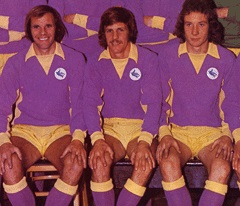
Questions going back to the sixties on tomorrow’s opponents – I’ll post the answers on here either tomorrow evening or Monday morning.
60s. This defender started off with his hometown, non league, club who play at a ground better known for another sport. Refusing to sign for local rivals until he had completed his A levels, he followed the manager who wanted him, who had just moved to Sheffield Wednesday, after he had passed his exams. Although he did play First Division football at Hillsborough, he was always seen as cover for the first team and left them after four years, having featured less than fifty times. He played more than four times as many games for his next club, who had the biggest pitch in the country as a claim to fame, a ground which sounded distinctly French and not a great deal of success. He did better at his final club where he played under a future England manager at a ground which has a stand now named “Poacher’s Corner”.
Ending a pretty modest playing career in 1977, he did better in management, especially at his first club where he enjoyed a record breaking winning run on the way to one of two promotions he achieved. Getting his chance in the top flight, the fact he stayed in post for three and a half years tells you he wasn’t a failure, but his style of play wasn’t popular with fans and a somewhat fraught relationship with the club’s talisman didn’t help his cause either. His final job in management was a two year spell alongside a river, can you name him?
70s. Can you recognise this player?
Educated at Anfield Comprehensive School, this winger had a short, unproductive, spell by the Lancashire sea side before dropping into non league football, Signed by Wednesday at the start of the decade, he quickly broke into the first team and, although it was a club in decline then, he was generally reckoned to be one of the best players in what was a poor team (and he could at least point to having played against Pele in his time with them). Having played for the newer version of his second club during his non league days, his form earned him an upwards move to the original version after more than one hundred and fifty games at Hillsborough. Again by the seaside, he didn’t always play, but did score some important goals and then left after a season to see out his career in his native county. He spent two years at each of his last three clubs – the first being a team that a famous plumber once played for, the second the residents of a stretch of grassy, open, uncultivated land and the third a side that were much in the news during the summer and early autumn for the wrong reasons.
80s. Inept sounding lawman features in Cardiff v Sheffield Wednesday match?
90s. Tangled leg joins men to produce a goalscorer.
00s. An England international remembered for the “interesting” thing he was photographed with in his holiday snaps one year, he was also part of a Wednesday squad beaten at home by City during this decade, can you name him?
10s. Who is this member of the Sheffield Wednesday squad which played here in October?

Answers.
60s. Gateshead born Ian Branfoot was going to sign for Sunderland, but, after taking his A levels, followed manager Alan Brown to Sheffield Wednesday in 1965. Moving on to Doncaster and then Lincoln City, where he played under Graham Taylor, he clocked up over three hundred and fifty matches in a twelve year career. Branfoot was named Reading manager in 1984 and the club were promoted from the old Division Four in his first season. Two years later, Reading won their first thirteen matches of the season on their way to the Third Division title and, although they were relegated in 1988, there was partial compensation with victory in the Full Members Cup as Luton were beaten at Wembley. After leaving Reading, Branfoot managed Southampton from June 1991 until January 1994, falling out with Matt LeTissier now and again along the way. A largely unsuccessful spell as Fulham boss followed and he left management for good in 1996.
70s. Eric Potts was born in Liverpool and first joined Blackpool, but left them without playing a senior game. New Brighton were among the non league sides he played for before he signed for Sheffield Wednesday in 1970. Seven years later, he was signed by Brighton and then returned to Lancashire to play for Preston, Burnley and Bury.
80s. Marshall Burke played for City in their 5-2 defeat at Hillsborough in December 1983 during his loan spell from Lincoln.
90s. Nigel Jemson.
00s. Gabriel Agbonlahor came on as a sub for Sheffield Wednesday in their 3-1 home defeat by a Jason Koumas inspired City in November 2005 while he was on loan to them from Aston Villa. Eleven years later, Villa launched an enquiry into allegations that Agbonlahor had been photographed appearing to hold a shisha pipe while on holiday in Dubai – a fortnight later, he was suspended by the club following claims he had been pictured with laughing gas containers.
10s. Moses Odubajo.



